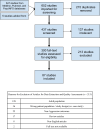Genetics of child aggression, a systematic review
- PMID: 38862490
- PMCID: PMC11167064
- DOI: 10.1038/s41398-024-02870-7
Genetics of child aggression, a systematic review
Abstract
Excessive and persistent aggressiveness is the most common behavioral problem that leads to psychiatric referrals among children. While half of the variance in childhood aggression is attributed to genetic factors, the biological mechanism and the interplay between genes and environment that results in aggression remains elusive. The purpose of this systematic review is to provide an overview of studies examining the genetics of childhood aggression irrespective of psychiatric diagnosis. PubMed, PsycINFO, and MEDLINE databases were searched using predefined search terms for aggression, genes and the specific age group. From the 652 initially yielded studies, eighty-seven studies were systematically extracted for full-text review and for further quality assessment analyses. Findings show that (i) investigation of candidate genes, especially of MAOA (17 studies), DRD4 (13 studies), and COMT (12 studies) continue to dominate the field, although studies using other research designs and methods including genome-wide association and epigenetic studies are increasing, (ii) the published articles tend to be moderate in sizes, with variable methods of assessing aggressive behavior and inconsistent categorizations of tandem repeat variants, resulting in inconclusive findings of genetic main effects, gene-gene, and gene-environment interactions, (iii) the majority of studies are conducted on European, male-only or male-female mixed, participants. To our knowledge, this is the first study to systematically review the effects of genes on youth aggression. To understand the genetic underpinnings of childhood aggression, more research is required with larger, more diverse sample sets, consistent and reliable assessments and standardized definition of the aggression phenotypes. The search for the biological mechanisms underlying child aggression will also benefit from more varied research methods, including epigenetic studies, transcriptomic studies, gene system and genome-wide studies, longitudinal studies that track changes in risk/ameliorating factors and aggression-related outcomes, and studies examining causal mechanisms.
© 2024. The Author(s).
Conflict of interest statement
JLK is a member of the Scientific Advisory Board of Myriad Neurosciences Inc. JLK and CCZ are authors on patents for pharmacogenetic interventions and suicide markers. EK, TK, and AT reported no conflict of interest related to this paper.
Figures


Similar articles
-
Monoamine Oxidase A (MAOA) and Catechol-O-Methyltransferase (COMT) Gene Polymorphisms Interact with Maternal Parenting in Association with Adolescent Reactive Aggression but not Proactive Aggression: Evidence of Differential Susceptibility.J Youth Adolesc. 2016 Apr;45(4):812-29. doi: 10.1007/s10964-016-0442-1. Epub 2016 Mar 1. J Youth Adolesc. 2016. PMID: 26932718
-
Modification of the association between early adversity and obsessive-compulsive disorder by polymorphisms in the MAOA, MAOB and COMT genes.Psychiatry Res. 2016 Dec 30;246:527-532. doi: 10.1016/j.psychres.2016.10.044. Epub 2016 Oct 24. Psychiatry Res. 2016. PMID: 27821364
-
Catecholamines and aggression: the role of COMT and MAO polymorphisms.Ann N Y Acad Sci. 2004 Dec;1036:393-8. doi: 10.1196/annals.1330.023. Ann N Y Acad Sci. 2004. PMID: 15817751 Review.
-
Polymorphisms in the MAOA, MAOB, and COMT genes and aggressive behavior in schizophrenia.Am J Med Genet B Neuropsychiatr Genet. 2004 Jul 1;128B(1):19-20. doi: 10.1002/ajmg.b.30021. Am J Med Genet B Neuropsychiatr Genet. 2004. PMID: 15211623
-
Molecular genetics and antisocial behavior: where do we stand?Exp Biol Med (Maywood). 2014 Nov;239(11):1514-23. doi: 10.1177/1535370214529508. Epub 2014 Apr 24. Exp Biol Med (Maywood). 2014. PMID: 24764243 Review.
Cited by
-
Evaluation of epistasis detection methods for quantitative phenotypes.bioRxiv [Preprint]. 2025 May 14:2025.04.30.651312. doi: 10.1101/2025.04.30.651312. bioRxiv. 2025. PMID: 40463086 Free PMC article. Preprint.
-
Association of Lower COMT Activity Alleles with Aggressive Traits in Male Youth with Conduct Disorder Living in a Correctional Facility.Biomolecules. 2025 Apr 9;15(4):554. doi: 10.3390/biom15040554. Biomolecules. 2025. PMID: 40305338 Free PMC article.
-
Suicidal risk in patients with aggression in schizophrenia: a systematic review.Front Psychiatry. 2025 Apr 24;16:1560699. doi: 10.3389/fpsyt.2025.1560699. eCollection 2025. Front Psychiatry. 2025. PMID: 40343103 Free PMC article.
-
Longitudinal reciprocal relationship between media violence exposure and aggression among junior high school students in China: a cross-lagged analysis.Front Psychol. 2025 Jan 7;15:1441738. doi: 10.3389/fpsyg.2024.1441738. eCollection 2024. Front Psychol. 2025. PMID: 39839937 Free PMC article.
-
Ethical issues in the use of genetic predictions of aggressive behavior in the criminal justice system: a systematic review.Front Genet. 2025 May 13;16:1599750. doi: 10.3389/fgene.2025.1599750. eCollection 2025. Front Genet. 2025. PMID: 40432882 Free PMC article.
References
-
- World Health Organization. Youth violence. 2020 May 10, 2022]; Available from: https://www.who.int/news-room/fact-sheets/detail/youth-violence.
-
- Centers for Disease Control and Prevention. Preventing youth violence. 2022 April 14, 2022]; Available from: https://www.cdc.gov/violenceprevention/youthviolence/fastfact.html.
Publication types
MeSH terms
Substances
LinkOut - more resources
Full Text Sources
Miscellaneous

